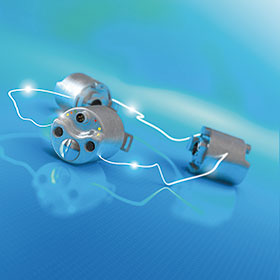

The latest generation of Ethernet encoders from SICK opens up new opportunities for obtaining measurements in addition to the data related to tracking movements. This new information can be used for effective status monitoring.
It would be very useful to know how often a motor has actually turned, instead of only being given information about the period when a voltage is applied to it. Obtaining actual figures about the number of times a machine component has changed its position during the production process could also be valuable. In both cases, the encoder first has to perform its original function of precisely identifying the position of components and passing this information to the controller or to a servo converter within a closed control loop. However, the cycle frequency of the components provides important information about their service life in the long term. This counted data is a much more useful solution than simply checking the date of manufacture and installation of machines when evaluating the condition of production facilities.
The power-up times only offer limited information about the service life, the ageing of operating materials and the wear levels. This new approach is particularly useful when a machine's components have different service lives because it allows individual parts that have reached the end of their life to be replaced during the course of regular or preventive maintenance.
The motion timer function of SICK's Ethernet encoders makes it possible to record the encoder's operating hours accurately. While the operating time meter in power-up mode only provides information about the number of the hours when the encoder is live, the motion timer records the periods when the encoder is actually moving. It also counts the number of times the encoder is powered up. This means that maintenance can be carried out only when it is needed, which helps to prevent downtime.
Another possible scenario in which Ethernet-based encoders can improve the availability of production facilities is temperature monitoring. If temperature sensors are used in processes, their primary function is to measure the process temperatures or to protect components such as motors from shutting down because of the heat. The latest encoders from SICK, in addition to providing temperature monitoring and control functions, can also measure their own temperature. This information allows conclusions to be drawn about the temperature profile of the entire process and, when combined with other parameters, can be used for application-specific condition monitoring.
The appeal of this solution lies in the fact that one single encoder can supply the traditional process data, such as position and speed, via industrial Ethernet protocols and at the same time can make use of additional functions and configurations via TCP/IP. For this reason, SICK fits its Ethernet encoders with a dual port switch. Separating the machine function from the overlying status monitoring process opens up the possibility of performing these higher level tasks independently, regardless of the possible restrictions imposed by a machine controller that may be inaccessible.
In practice, intelligent SICK encoders can be configured to meet the requirements of individual applications or of specific conditions in the areas where they are used. By setting the limits and thresholds individually and directly in the encoder via the software system in the PLC or via a web server and a browser-compatible end device, the correct measuring range can be specified for every application with a high level of standardisation. When the specified position, speed and temperature thresholds are reached, the encoder automatically sends a signal via the Ethernet connection to indicate that an investigation must be carried out. This function operates independently of the machine controller.
Communication via the well-established industrial Ethernet protocols – Ethernet I/P, EtherCAT and Profinet – allows the process data to be converted to the most suitable mathematical and physical units and evaluated accordingly. As the data is imported into control or MES systems in the right format, no further calculations are needed to produce the required figures. Because the Ethernet encoders are so adaptable, they can be reconfigured during the operating phase if the detailed features of the measurements change.
The adaptability of SICK's encoders also extends to their connectivity, in particular with regard to plug options, mechanical supports and cable lengths. Customising is based on a sophisticated variant management system, with flexible production options down to a batch size of 1. This is perfect for Industry 4.0, the industrial revolution that puts the emphasis on individualised large-scale production.
For more information contact Robert de Scánde, SICK Automation Southern Africa, +27 (0)11 472 3733, [email protected], www.sickautomation.co.za
| Tel: | +27 10 060 0550 |
| Email: | [email protected] |
| www: | www.sick.com/za/en/ |
| Articles: | More information and articles about SICK Automation Southern Africa |

© Technews Publishing (Pty) Ltd | All Rights Reserved